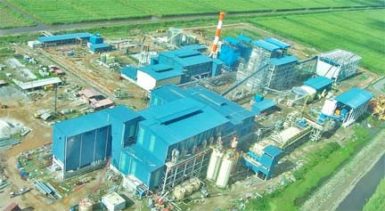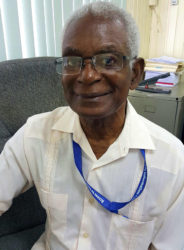The deplorable state of the Skeldon Estate and the expenses it is incurring have pushed the Guyana Sugar Corporation (GuySuCo) Board to look at the options of either selling or diversifying it.
This is according to Chairman of the Board Dr Clive Thomas, who told Stabroek News in an interview that they have already spoken to potential buyers and are awaiting the go ahead from government to continue the discussions.
Contributing to the estate’s woes is the US$110 million Chinese-built factory, conceived by the PPP/C government to secure the future of the sugar industry, which has been a poor performer from the inception and has produced nowhere near the 110,000 tonnes of sugar that was promised each year.


According to Thomas, selling the estate is one of the options the Board has but its members have also made other proposals to Cabinet and are awaiting a decision.
With regard to the option for diversification, Thomas said: “Basically what we are trying to do is to diversify to consolidate the production of sugar,” for the higher-priced local, Caricom and US markets.
The next step, he said, “Would be to go for value-added sugar and also to try to establish and convince the rest of the Caribbean that we should be the sole producer of refined sugar. In that case we would set up a refinery. Those are the primary thoughts at this time.”
A recent study done at the estate by the Wartsila Company “showed that the cost of producing the cane was something we cannot afford. At the moment, we are earning [US] 22 cents per pound and the estate is producing at [US] 37 cents per pound.”
He emphasized that the state of the factory and the cost of repairs are beyond what GuySuCo can afford. And based on a recent report, the condition of the estate is “deplorable and would need quite a few million US dollars to bring it up to speed.”
“What is worse,” Thomas said, “is that the labour cost that they entail for producing the cane and the sugar is less than the revenue received from selling it.
“When the workers go on strike, paradoxically the company saves money because it doesn’t have to pay them.”
Skeldon Sugar Modernisation Project
The new factory at Skeldon was part of the Skeldon Sugar Modernisation Project (SSMP), which also involved expanded cane cultivations, the establishment of a refinery and the co-generation of electricity for the national grid. The brainchild of former president Bharrat Jagdeo, the SSMP started in 2003, two years after his first full term as president began.
According to the report of the Commission of Inquiry (CoI) into GuySuCo, the SSMP was initially estimated to cost US$165 million. The project eventually ended up costing US$187 million with funding from the World Bank of US$56 million, Exim China Bank – US$32 million, the Caribbean Development Bank – US$24 million and GuySuCo – US$53 million.
The report noted that GuySuCo’s contribution of US$53 million was intended to come from the sale of its land around Guyana. However, this did not materialise and the sugar corporation used its own resources thereby depleting its working capital. The escalation in the cost from US$165 million to US$187 million was also funded out of GuySuCo’s own resources.
The China National Technology Import and Export Corporation (CNTIC) was contracted to build the new Skeldon factory at a cost of US$110 million, which was part of the SSMP US$187 million. CNTIC underperformed and the then government ignored recommendations by Booker Tate a UK-based management firm that was hired to look at the design and oversee the implementation of the SSMP, to terminate that contract.
The factory was commissioned in August 2009 amid much hype with the previous administration saying that it would increase sugar production. Jagdeo had said that the factory was designed to have the capabilities to produce sugar for US 12 cents per pound.
When the factory subsequently encountered major problems, he blamed Booker Tate and accused it of “incompetence.”
South African firm Bosch Engineering was hired in 2013 to rectify work done by CNTIC at the Skeldon factory and to undertake rehabilitation. According to the CoI report, US$7 million had to be spent on corrective work on the factory.
Under the SSMP, the National Cane Farmers’ Committee in the Upper Corentyne area had been resuscitated. The private farmers were expected to supply most of the cane but it never reached the amount that the factory had capacity to grind.
Thomas said the SSMP failed because the structure and the layout of the factory were built to bad specifications. In fact, he said, although a lot of money was spent on repairs, some parts of the factory were dangerous to health. “At least one worker was severely burnt by the steam from the sugar boiler late last year. This was caused by poor safety practices by the estate so the problems are very significant,” he added.
This newspaper learnt that a study completed in March 2016 found that there was damage to the steam turbine and reduction gear instrument wiring, there were generator lube oil jacking pump and oil leakages in the generators. It was also noted that most of the lighting in the turbine hall (powerhouse) was not working and that the lack of spare parts, such as the generator diodes, measuring transformer and turbine controller), risk production losses in case of a failure. There were also reports of heat loss in the steam system, resulting from many leaks in the process steam header. In the case of the water treatment, the study found that feed-water quality was poor and that all dousing has to be done manually because the automation system was not functioning.
Diversification
Meanwhile, the Wales estate will be diversified at the end of this crop and GuySuCo has started preparation for growing rice mainly to be used as “seed paddy” on 483 of its 5,000 acres. Thomas said that that seeds grow best from virgin land and that they would look to go into specialty brands rice, like the aromatic variety.
“Since we are hoping to produce in large quantities we hope to find niche markets where we can get better prices than average,” he told this newspaper.
“We already have people who are interested, from the United States and Europe who have indicated their interest in purchasing small quantities… while a few hundred tonnes would be sold” to other places.
Suggestions had been made that the workers be given land and Thomas said this would be the case and they would produce crops based on feasibility studies already conducted by GuySuCo.
He said too that other estates would soon be diversified, “but the Blairmont, Albion and we have already committed to Uitvlugt… as well as Enmore which was already merged with the East Demerara Estate” would “definitely be retained.”
Wales, according to him, is a “pilot estate and we’re testing the diversification options there… We would try to encourage the farmers to participate in that by offering them the land.”
GuySuCo also has plans to develop a number of industries in the agricultural sector including the processing of fruits and fruit juices, the establishment of a pasteurization plant as well as aquaculture and apiculture.
He said recommendations were made for diversification into food crops, livestock and milk production. He noted too that: “Experts came in to help develop the feasibility studies for projects” such as for biogas and fish feed.
Thomas pointed out too that the Skeldon estate produced “bagasse power that served about 90,000 households in the Berbice area. But now that bagasse factory is so run down that the investment did not prove to be a good one.”
Meanwhile, he said that in 1996, the National Development Strategy had proposed that GuySuCo divest most of the land to the private cane farmers but none was ever given to them.





